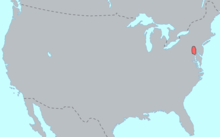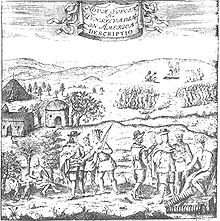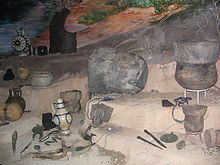- Susquehannock
-
Susquehannock Total population Extinct as tribe Regions with significant populations New York, Pennsylvania, Maryland Languages Iroquoian
Religion Native
Related ethnic groups The Susquehannock people were Iroquoian-speaking Native Americans who lived in areas adjacent to the Susquehanna River and its tributaries from the southern part of what is now New York, through Pennsylvania, to the mouth of the Susquehanna in Maryland[1] at the north end of the Chesapeake Bay. Evidence of their habitation has also been found in West Virginia.
The people were called:
- Andastes by the French (adapted from the Huron name Andastoerrhonon, meaning "people of the blackened ridge pole[2]);
- Minquas by the Dutch and Swedes, adapted from the Algonquian Lenape/Delaware ethnonym for their traditional enemy, which meant "treacherous";
- Susquehannock by the English of Maryland and Virginia (adapted from Sasquesahanough, the name told to Captain John Smith by his Powhatan-speaking interpreter, translating to "people at the falls" or "muddy water people," due to the Susquehanna River nearby.[3] ; and
- Conestogas by the English of Pennsylvania (adapted from Kanastoge ("place of the immersed pole"), the name of a Susquehanna village in Pennsylvania).
There is no record of the Susquehannock autonym, i.e. what they called themselves.
Contents
History
Susquehannock artifacts on display in the State Museum of Pennsylvania in Harrisburg.
The true nature of their society, whether a single tribe in a single village, or a confederacy of smaller tribes occupying scattered villages, may never be known. The Susquehannock nation remained independent and not part of any confederacy into the 1600s, but they did not stand a chance in the wars of that century,[4] and were ultimately annexed in 1677 by their former enemies and distant kin, the Haudenosaunee (Iroquois) Five Nations. Europeans seldom visited this inland region during the early colonial period. It is likely that the Susquehannock had occupied the same land for several hundred years.
Archeologists have found evidence of the people on the Potomac River and its tributaries, artifacts which they have classified as the "late Susquehannock sequence". Materials have been found in Pennsylvania, and Maryland's Allegany County at the Barton (18AG3) and Llewellyn (18AG26) sites. West Virginia's Grant, Hampshire and Hardy counties region (Brashler 1987) possess archaeological sites having Susquehannock ceramics. A Contact Period (1550~1630) Susquehanna site, 46Hy89,[5][6] is located in the Eastern Panhandle at Moorefield, West Virginia.[7]
When Captain John Smith of Jamestown met them in 1608, they had a formidable village in the lower river valley near present-day Lancaster, Pennsylvania. Captain Smith wrote of the Susquehannock, "They can make neere 600 able and mighty men, and are pallisadoed in their Townes to defend them from the Massawomekes their mortall enimies." He was astonished to find the Susquehannock were brokering trade with French goods. He estimated the population of their village to be 2,000, although he never visited it.
The French explorer Samuel Champlain noted the Susquehannock in his Voyages of Samuel Champlain; in 1615, he called one of their 20 villages, Carantouan. It was located on the upper Susquehanna River near present-day New York state. It rallied more than 800 warriors with two other villages, Champlain reported. Modern estimates of their population, including the whole territory in 1600, range as high as 7,000 people.
Subtribes were little known; they included the Akhrakouaeronon. The French name Andaste, from Andastoerrhonon, may refer to another subtribe. Possible related tribes include the Scahentoarrhonon, Onojutta-Haga and the Tehotitachsae.
During the early colonialization of New Netherland, the Susquehannock traded furs with the Dutch. As early as 1623, they were struggling to get past the Lenape (later known as the Delaware) along the Delaware River to trade with the Dutch at New Amsterdam. In 1634, The Susquehannock defeated the Delaware, who may have become tributaries. In 1638, Swedish settlers established New Sweden in the Delaware Valley, at a location enabling them to intercept the Susquehannock fur trade with the Dutch.
In 1642, the English Province of Maryland declared war on the Susquehannock. With the help of the Swedes, the Susquehannock defeated the English in 1644. The Susquehannock were in an inactive state of war with Maryland until 1652. As a result, they traded almost exclusively with New Sweden. In 1652 they concluded a peace treaty with Maryland. In return for arms and safety on their southern flank, they ceded to Maryland large territories on both shores of the Chesapeake Bay.
During the Beaver Wars of the 1650s, for a period the Susquehannocks formed an alliance with the Province of Maryland, receiving rifles and other European weapons to fight off the Iroquois Confederacy. They were successful in doing so and a brief peace followed.
In 1658, the Susquehannock used their influence with the Esopus to end the Esopus Wars, because that conflict interfered with the important trade with the Dutch. From 1658 to 1662, the Susquehannock were at war with the powerful Iroquois confederacy to the north, which was trying to dominate the fur trade. By 1661, Maryland's treaty of peace was expanded to a full alliance between the Maryland colonists and the Susquehannock against the Iroquois. Besides goods and arms, fifty Englishmen were assigned to the Susquehannock to guard their fort.
In 1663, a large Iroquois invasion force was defeated at the home fort of the Susquehannock. In April 1663, the Susquehannock village on the upper Ohio River was also attacked by Seneca, Cayuga, Onondaga (JR: 48:7-79, NYCD 12:431).
In 1669-70, John Lederer's guide was a Susquehanna on his journey to the south west Virginia and North Carolina (Mooney 1894:32). Paula W. Wallace writes, "In 1669 Iroquois Indians warned the French that if they tried to descend the Ohio River they would be in danger from the "Andastes." (Susquesahanocks: Wallace 1961:13).
In 1672, the Susquehannock defeated an Iroquois war party. The Iroquois appealed to the French for support because the Iroquois could not "defend themselves if the others came to attack them in their villages". Some old histories indicate that the Iroquois defeated the Susquehannock, but no record of a defeat has been found.[8]
In 1675 the Susquehannock suffered a major defeat when they again waged war with the Iroquois Confederacy. English colonists invited the Susquehannock to resettle in Maryland, where they relocated because of pressure from the Iroquois. They became embroiled in Bacon's Rebellion the following year.[9] After some Doeg Indians killed some Virginians, Virginians crossed into Maryland and killed Susquehannock in retaliation. Virginia militia in alliance with Maryland militia surrounded the Susquehannock village on the Potomac. The Susquehannock held out for six weeks.
Virginia's governor was overthrown by Nathaniel Bacon, who promised to exterminate the Susquehannock. Instead he attacked some friendly Occaneechee.
Governor Edmund Andros of the Province of New York told the Susquehannock they would be welcome in New York and that he would protect them from Maryland and Virginia. The Mohawk Nation invited them to move to New York as guests of the Iroquois. Some moved to their homeland on the Susquehanna River, some fled to the Iroquois for shelter, and others moved to the upper Delaware River under the protection of New York.
In 1677, however, New York ordered the Susquehannock to be expelled from the Delaware Valley. After adopting the majority of the Susquehannock, the Iroquois acquired a right to most of the Susquehanna River, but they never claimed below the falls. Southwesterly, the remnant Susquehanna and Meherrin, and allied Nottoway or Mangoac, the Iroquoian stock of the Virginias called themselves Chiroenhaka according to James Mooney. There is of late archaeological evidence of Susquehannock movement into and habitation such as the Mouth of the Seneca (46Pd1) and Pancake Island (46Hm73) villages according to Bryan Ward, 2009, West Virginia Division of Culture and History.
Over the next hundred years, the Susquehannock population was devastated by the ravages of new Eurasian infectious diseases, which were endemic among the Europeans, and warfare. The remaining Susquehannock, numbering only a few hundred, settled in a new village in Lancaster County called Conestoga Town. They lived under the protection of the provincial government of the Pennsylvania Commonwealth, but their population declined steadily. In 1763, a census counted only twenty-two people in Conestoga Town. That year the Paxton Boys, in response to Pontiac's Rebellion on the western frontier, attacked the village.
The Paxton Boys slaughtered six people at Conestoga. The remaining Indians were taken to a Lancaster workhouse for protection by the Commonwealth. The governor found the acts unacceptable and discouraged any further violence. Two weeks later, the Paxton Boys killed the remaining 14 people at the workhouse. [10] Clb5273 (talk) 23:50, 16 October 2011 (UTC)
The Susquehannock appear to have been a confederacy of at least five tribes with more than 20 villages, the names of which unfortunately have been lost.
Language
Main article: Susquehannock languageThe Susquehannocks were an Iroquoian-speaking people. Little of the Susquehannock language has been preserved. Almost the only source is a Vocabula Mahakuassica compiled by the Swedish missionary Johannes Campanius during the 1640s. Campanius's vocabulary contains only about 100 words, but it is sufficient to show that Susquehannock was a northern Iroquoian language, closely related to those of the Five Nations. Huron or Wyandot, was the language of the Susquehannock people, which is part of the Iroquoian language family
Footnotes
- ^ Henry George Hahn, Carl Behm, Towson: A Pictorial History of a Maryland Town, pgs. 12-13, Baltimore, MD: Donning Co., 1977, ISBN 0915442361
- ^ Wallace: Indians in Pennsylvania
- ^ "Susquehannock State Park History". Susquehannock State Park. http://www.dcnr.state.pa.us/stateparks/findapark/susquehannock/index.htm. Retrieved 10/20/2011.
- ^ Dean R. Snow, Archaeology of Native North America
- ^ "Susquehannock, Images from Moorefield Village Site 46Hy89", Council for West Virginia Archaeology
- ^ Maymon, Jeffery H. and Thomas W. Davis (1998), "A Contact Period Susquehannock Site in the Upper Potomac River Drainage: Data Recovery at Site 46HY89, Moorefield, West Virginia", Abstract of paper presented at the 28th Annual Meeting of the Middle Atlantic Archaeological Conference, Cape May, New Jersey.
- ^ Brashler, J.G. 1987. "A Middle 16th Century Susquehannock Village in Hampshire County, West Virginia," West Virginia Archeologist 39(2): 1-30.
- ^ Jennings, p. 135
- ^ Waldman. Native American Tribes. p. 286
- ^ "Susquehannock State Park". Susquehannock State Park. Pennsylvania Department of Conservation and Natural Resources. http://www.dcnr.state.pa.us/stateparks/findapark/susquehannock/index.htm. Retrieved 10/20/2011.
- ^ Varga, Colin (Winter 2007). "Susquehannocks: Catholics in Seventeenth Century Pennsylvania". Pennsylvania Heritage Magazine XXXIII (1): 6–15.
Huron or Wyandot, was the language of the Susquehannock people, which is part of the Iroquoian language family.
References
- Illick, Joseph E. Colonial Pennsylvania: a History. New York: Scribner & Sons, 1976.
- Kent, Barry C. Susquehanna's Indians. Harrisburg: The Pennsylvania Historical and Museum Commission, 1984.
- Jennings, Francis, The Ambiguous Iroquois Empire, 1984, ISBN 0393017192
External links
- "Where are the Susquehannock?" at The Susquehannock Fire Ring
- "Susquehannock History" by Lee Sultzman
- Encyclopedia of Oklahoma History and Culture - Conestoga
- [1]
Categories:- Iroquoian peoples
- Northeast Woodland tribes
- Native American history of Maryland
- Native American history of New York
- Native American history of Pennsylvania
- Native American tribes in Maryland
- Native American tribes in Pennsylvania
- Algonquian ethnonyms
Wikimedia Foundation. 2010.





